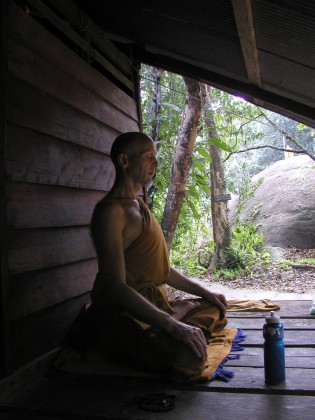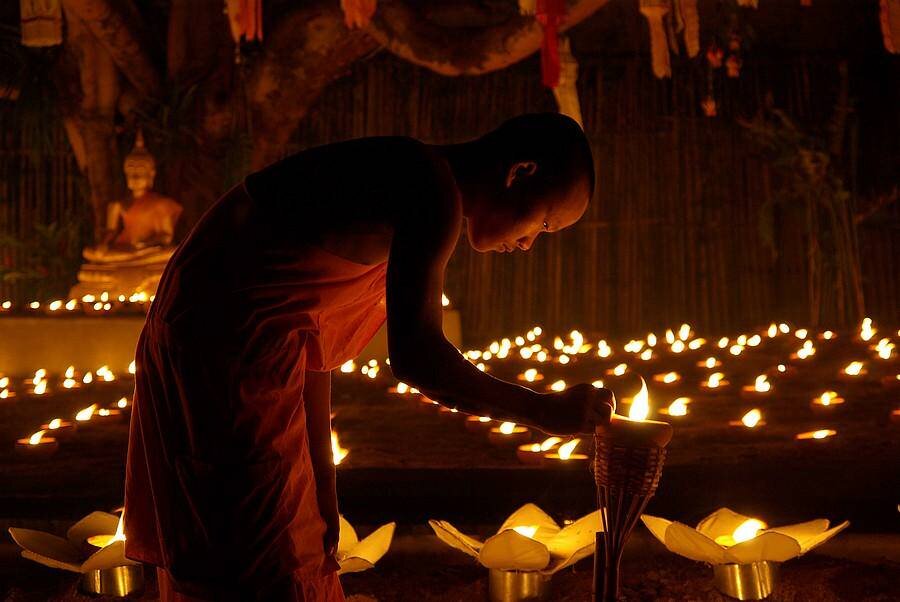Entering the ‘Vassa’ – Annual Rains Retreat
3 August 2012 marks the beginning of the Vassana or ‘Rains Retreat’ period for Theravada Buddhist monastics. The 3-month Vassana period from July-August to October-November corresponds with the monsoon season in South and Southeast Asia (which were historically Buddhist strongholds), thus making traveling very difficult and even dangerous. Monks and nuns were often invited by Buddhist communities to reside in village Aramas (monasteries and nunneries) for the duration of the ‘rains’.
The tradition of ‘Rains Retreat’ was started by the Buddha Himself in the year 588 BCE, where the Lord and 60 bhikkhus – including the elders Kondañña, Bhaddiya, Vappa, Mahānāma and Assaji, as well as Venerable Yasa and his 54 friends – resided in the vicinity of Sarnath near Varanasi. During those 3 months, the venerables learned and practised Dhamma intensively under the direct guidance of the Buddha; at the end of which, all 60 bhikkhus (monks) had attained the highest spiritual fruit of Arahantship.At the conclusion of that inaugural ‘Rains Retreat’, the Buddha instructed the Arahant elders to “Go forth O bhikkhus, for the welfare and happiness of the many, out of compassion for the world; propagate the Dhamma….excellent in the beginning, middle and end….in letter as well as in spirit… There are beings with little dust in their eyes, who without hearing the Dhamma will falter and fall away… There will be those who understand Dhamma.” The Buddha seeing that the period of intense spiritual practice and communal discipline had greatly benefitted the monks, formally instituted the ‘Rains Retreat’ whereby monks and nuns were to refrain from traveling and engaging in much activity to focus their attention inwardly towards spiritual development and purification.The Buddha also encouraged lay devotees to support the material needs of the monks during this 3-month period so as to free the practitioners to concentrate on spiritual work. At the end of the rough-weathered and monsoonal ‘Rains Retreat’, many of the monks’ robes were often close to tatters; hence the Buddha also allowed monks to receive offerings of new cloth from lay devotees to be cut, sewn and died into new robes. This allowance has today evolved into the much-celebrated ‘Kathina’ Ceremony marking the end of Vassana.The Vassana period afforded lay people more opportunities to approach resident monks for Dhamma teachings and spiritual guidance. Thus, the close symbiotic relationship between the monastics and the laity was further cemented.
The Buddha seeing that the period of intense spiritual practice and communal discipline had greatly benefitted the monks, formally instituted the ‘Rains Retreat’ whereby monks and nuns were to refrain from traveling and engaging in much activity to focus their attention inwardly towards spiritual development and purification.The Buddha also encouraged lay devotees to support the material needs of the monks during this 3-month period so as to free the practitioners to concentrate on spiritual work. At the end of the rough-weathered and monsoonal ‘Rains Retreat’, many of the monks’ robes were often close to tatters; hence the Buddha also allowed monks to receive offerings of new cloth from lay devotees to be cut, sewn and died into new robes. This allowance has today evolved into the much-celebrated ‘Kathina’ Ceremony marking the end of Vassana.The Vassana period afforded lay people more opportunities to approach resident monks for Dhamma teachings and spiritual guidance. Thus, the close symbiotic relationship between the monastics and the laity was further cemented. In the Theravada School of Buddhism, the tradition of observing the Vassana persists till today. In fact, the ‘seniority’ of a Theravada bhikkhu (monk) is reckoned by the number of ‘Rains Retreat’ he has observed since his Upasampada (higher ordination).The continuation of the Buddha-Sasana very much depends upon the upholding of the Buddha’s teachings (Dhamma) and discipline (Vinaya) by both the monastic and lay communities. And as long as there is practice and realization of the Dhamma, the world will never be deprived of the Buddha’s profound wisdom. We respectfully wish all venerable monastics a joyful and peaceful abiding.Namo Sanghaya! @Nalanda Institute
In the Theravada School of Buddhism, the tradition of observing the Vassana persists till today. In fact, the ‘seniority’ of a Theravada bhikkhu (monk) is reckoned by the number of ‘Rains Retreat’ he has observed since his Upasampada (higher ordination).The continuation of the Buddha-Sasana very much depends upon the upholding of the Buddha’s teachings (Dhamma) and discipline (Vinaya) by both the monastic and lay communities. And as long as there is practice and realization of the Dhamma, the world will never be deprived of the Buddha’s profound wisdom. We respectfully wish all venerable monastics a joyful and peaceful abiding.Namo Sanghaya! @Nalanda Institute
 The Buddha seeing that the period of intense spiritual practice and communal discipline had greatly benefitted the monks, formally instituted the ‘Rains Retreat’ whereby monks and nuns were to refrain from traveling and engaging in much activity to focus their attention inwardly towards spiritual development and purification.The Buddha also encouraged lay devotees to support the material needs of the monks during this 3-month period so as to free the practitioners to concentrate on spiritual work. At the end of the rough-weathered and monsoonal ‘Rains Retreat’, many of the monks’ robes were often close to tatters; hence the Buddha also allowed monks to receive offerings of new cloth from lay devotees to be cut, sewn and died into new robes. This allowance has today evolved into the much-celebrated ‘Kathina’ Ceremony marking the end of Vassana.The Vassana period afforded lay people more opportunities to approach resident monks for Dhamma teachings and spiritual guidance. Thus, the close symbiotic relationship between the monastics and the laity was further cemented.
The Buddha seeing that the period of intense spiritual practice and communal discipline had greatly benefitted the monks, formally instituted the ‘Rains Retreat’ whereby monks and nuns were to refrain from traveling and engaging in much activity to focus their attention inwardly towards spiritual development and purification.The Buddha also encouraged lay devotees to support the material needs of the monks during this 3-month period so as to free the practitioners to concentrate on spiritual work. At the end of the rough-weathered and monsoonal ‘Rains Retreat’, many of the monks’ robes were often close to tatters; hence the Buddha also allowed monks to receive offerings of new cloth from lay devotees to be cut, sewn and died into new robes. This allowance has today evolved into the much-celebrated ‘Kathina’ Ceremony marking the end of Vassana.The Vassana period afforded lay people more opportunities to approach resident monks for Dhamma teachings and spiritual guidance. Thus, the close symbiotic relationship between the monastics and the laity was further cemented. In the Theravada School of Buddhism, the tradition of observing the Vassana persists till today. In fact, the ‘seniority’ of a Theravada bhikkhu (monk) is reckoned by the number of ‘Rains Retreat’ he has observed since his Upasampada (higher ordination).The continuation of the Buddha-Sasana very much depends upon the upholding of the Buddha’s teachings (Dhamma) and discipline (Vinaya) by both the monastic and lay communities. And as long as there is practice and realization of the Dhamma, the world will never be deprived of the Buddha’s profound wisdom. We respectfully wish all venerable monastics a joyful and peaceful abiding.Namo Sanghaya! @Nalanda Institute
In the Theravada School of Buddhism, the tradition of observing the Vassana persists till today. In fact, the ‘seniority’ of a Theravada bhikkhu (monk) is reckoned by the number of ‘Rains Retreat’ he has observed since his Upasampada (higher ordination).The continuation of the Buddha-Sasana very much depends upon the upholding of the Buddha’s teachings (Dhamma) and discipline (Vinaya) by both the monastic and lay communities. And as long as there is practice and realization of the Dhamma, the world will never be deprived of the Buddha’s profound wisdom. We respectfully wish all venerable monastics a joyful and peaceful abiding.Namo Sanghaya! @Nalanda Institute

